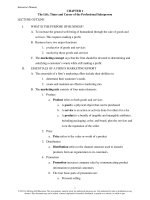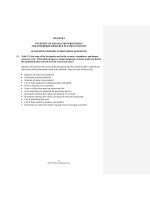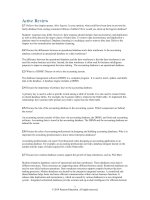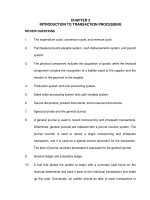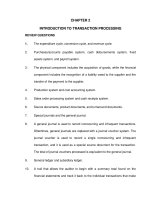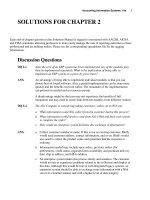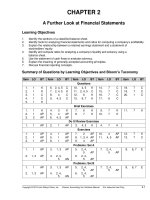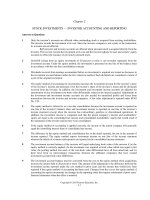Test bank and solution of ethics in business research (1)
Bạn đang xem bản rút gọn của tài liệu. Xem và tải ngay bản đầy đủ của tài liệu tại đây (1.27 MB, 28 trang )
Chapter 02 - Ethics in Business Research
Chapter 2
Ethics in Business Research
CHAPTER LEARNING OBJECTIVES
After reading this chapter, students should understand…
What issues are covered in research ethics.
The goal of “no harm” for all research activities and what constitutes “no harm” for
participant, research, and research sponsor.
The differing ethical dilemmas and responsibilities of researchers, sponsors, and research
assistants.
The role of ethical codes of conduct in professional associations.
The major objective of this chapter is to stimulate dialog about values and research
constraints. Exhibit 2-1 is the ideal platform for discussing these issues.
The themes of the chapter are organized around the ethical treatment of participants and
clients, and the ethical behavior of researchers. Major professional associations have
developed their codes of ethics and some of these associations are listed in the section on
Professional Standards.
The chapter also introduces students to key concepts and ethical issues involved in research,
such as procedures recommended for interviewers and researchers, issues of deception,
confidentiality, informed consent, institutional review boards, rights to privacy, and so on.
The analytical and decision complexities of ethical issues are best addressed through case
analysis, and the cases in the text take the students through diverse situations.
You may wish to treat the chapter as background reading, explain basic concepts, and then
use the cases as the key medium for analysis.
KEY TERMS
Key terms are shown in bold, as they appear in the text, throughout the lecture notes.
2-1
© 2014 by McGraw-Hill Education. This is proprietary material solely for authorized instructor use. Not authorized for sale or distribution
in any manner. This document may not be copied, scanned, duplicated, forwarded, distributed, or posted on a website, in whole or part.
Chapter 02 - Ethics in Business Research
POWERPOINT
A complete PowerPoint slide set comes with this chapter. It is organized as the
chapter is organized. Each chapter contains a complete review of chapter concepts
and issues. Each, at minimum, contains the following slides:
o Learning Objectives
o Pull Quote, used to open this chapter
o Exhibit art
o Key Terms
o Additional Discussion Opportunities: Section of slides at the end of the
chapter slide set that you can rearrange within the slide set as desired.
Suggestions for using these slides are in the notes section of each slide or in
the Discussion and Project Ideas section of this manual. This slide section
contains several types of slides, including but not limited to the following:
Additional Pull Quotes from Research Thought Leaders
PulsePoint: statistic drawn from a research project that relates to some
chapter concept
Each Snapshot in the chapter: mini-case that relates to one or more
chapter concepts.
Each PicProfile in the chapter: research related image that relates to
one or more chapter concepts or an emerging concept.
Each CloseUp in the chapter: more in depth profile of a research
concept or project.
TEST BANK
The test bank for each chapter contains the following:
Multiple choice objective questions of several types:
o Definition-based questions on key terms and concepts
o Application-based questions posing decision scenarios
o Application-based questions asking for justification or explanation
Essay Questions
An answer key for each question that indicates question difficulty level:
2-2
© 2014 by McGraw-Hill Education. This is proprietary material solely for authorized instructor use. Not authorized for sale or distribution
in any manner. This document may not be copied, scanned, duplicated, forwarded, distributed, or posted on a website, in whole or part.
Chapter 02 - Ethics in Business Research
DISCUSSION AND PROJECT IDEAS
Snapshots
o Privacy’s New Frontier…Location-Based Services…discusses the
advantages and disadvantages of using LBS in research.
o ESOMAR and CASRO on the Ethics of Mobile Surveys…discusses the
guidelines for mobile survey research followed by members of two of the
strongest professional associations in research.
o Has Trust Trumped Privacy…reveals current thinking on the issue of privacy
of information.
o Is Your Research Project Leaving the Country…raises a concern about
offshoring of research and the ethics and risks associated with the practice.
PicProfiles
o None in this chapter.
PulsePoint:
Published research reveals many ways that businesses use research. You might
use such research findings to discuss a current phase of the research process or a
current issue. You might use this statistic to discuss how employers could
research employee fraud without violating the privacy rights of employees who
are doing nothing wrong.
$944…The amount, in millions, that employers will lose this year due to
employee fraud.
Pull Quote
Use each chapter’s pullquote to discuss a current issue related to the chapter.
In this case, the quote deals with the emergence in business of the privacy
professional. You can use this quote to discuss the advantages and disadvantages
of having one person overseeing all issues related to employee, company, vendor,
and customer privacy.
“Today, it would be remiss to say that the privacy profession is anything but
flourishing. Companies are increasingly hiring privacy officers and even
elevating them to C-suite positions; the European Commission has proposed a
statute in its amended data protection framework that would require data
protection officers at certain organizations, and, at the International
Association of Privacy Professionals (IAPP) membership recently hit 10,000
worldwide.”
2-3
© 2014 by McGraw-Hill Education. This is proprietary material solely for authorized instructor use. Not authorized for sale or distribution
in any manner. This document may not be copied, scanned, duplicated, forwarded, distributed, or posted on a website, in whole or part.
Chapter 02 - Ethics in Business Research
Angelique Carson, CIPP/US,
International Association of Privacy Professionals
WWW Exercise
Do research companies have special ethical guidelines for research involving
children? Use a Web search engine like Google.com or Bing.com to find out.
o Instructors: www.ftc.gov and www.coppa.org will provide significant
information.
Visit at least two of the Web sites of research trade associations mentioned in
Exhibit 2-5 and compare their codes of ethics. Are these codes identical? If not,
what differences do you perceive?
Class discussion or research project:
Germany’s war history prompted the government to forbid many types of medical
research. Have students search the internet for information that will help them
answer the following questions, and then present it in report form:
o “What type(s) of medical research is currently banned in Germany?”
o “Which government agency monitors medical research?”
o “What are the penalties for violating the ban?”
If researchers are responsible for the ethical conduct of their research, are they
solely responsible for the burden of protecting participants from every
conceivable harm?
Have students research and present a report on the Nuremberg Code. The paper
should detail the circumstances that prompted the creation of the code, who
authored the code, and which countries and/or agencies are most impacted by it.
Have students research and present a report on the following laws:
o Public Law 95-38 (Privacy Act of 1974): the first law guaranteeing
Americans the right to privacy.
o Public Law 96-440 (Privacy Act of 1980): carries the right to privacy
further.
o 18 U.S.C. § 2710 (2002); Video Privacy Protection Act of 1988 provides
for a general ban on the disclosure of personally identifiable video rental
information unless the consumer consents specifically and in writing.
2-4
© 2014 by McGraw-Hill Education. This is proprietary material solely for authorized instructor use. Not authorized for sale or distribution
in any manner. This document may not be copied, scanned, duplicated, forwarded, distributed, or posted on a website, in whole or part.
Chapter 02 - Ethics in Business Research
CHAPTER VIGNETTE
BRINGING RESEARCH TO LIFE
Jason and Sara are discussing an action taken by a potential new client and Jason’s
response to that action.
Jason has met with a potential client that wanted him to do something Jason found
completely unethical: to conduct an exploratory research study into the proposed
and planned activities of a competitor by using a false job-interview format to lure
competitor’s employees seeking job advancement to the interviews—individuals
who would be unlikely to volunteer to participate in such an interview if the true
purpose was revealed.
Based on information gleaned from the actions of another executive, the computer
peripheral manufacturer had sent out a request for proposal (RFP), requesting
firms with focus-group facilities to submit proposals to conduct several taped,
individual depth interviews. The hidden purpose of the interviews was to discover
competitor’s growth plans. Supposedly, another firm had tried this and
successfully lured one of its major competitor’s director of business development
to apply for the fake position. In the context of the interview the executive had
revealed information about his employer’s growth plans in Mexico.
During the interview to determine if Henry and Associates will be awarded the
contract for this research project, Jason discovers that the project is not as it was
detailed in the RFP.
He leaves the interview, withdrawing his proposal and taking his company’s
physical proposal with him.
– He identifies the other companies vying for the project based on the proposals
clearly visible on the manufacturer’s desk.
– He calls his counterpart at the other research companies and reveals the true
purpose and design of the project being proposed.
–
Some Discussion Questions:
Who acted unethically here?
–
Is it appropriate/inappropriate for a potential client (the computer peripheral
manufacturer) to suggest a methodology to the person or firm it wants to do the
actual research?
– Was it appropriate/inappropriate for Jason to withdraw the Henry and
Associates proposal?
– Was it appropriate/inappropriate for Jason to use the visible covers of other
research suppliers’ proposals to identify the other companies competing for the
research contract.
2-5
© 2014 by McGraw-Hill Education. This is proprietary material solely for authorized instructor use. Not authorized for sale or distribution
in any manner. This document may not be copied, scanned, duplicated, forwarded, distributed, or posted on a website, in whole or part.
Chapter 02 - Ethics in Business Research
–
Was it appropriate/inappropriate for Jason to contact his counterpart at the
identified research companies to alert them to the situation that he had
discovered in the interview?
If research was done as the computer peripheral manufacturer suggested, what
would be appropriate actions for competitors?
–
Is there a basis for a fraud action by . . .
o A competing computer peripheral manufacturer against its competitor?
o A research company that would do the study as suggested?
o A research facility that would allow the described research to take place in
their facility.
Should an employee be terminated for revealing research results or business plans
to a competitor, even if he/she is tricked into doing so?
Should a researcher be terminated for revealing research results or business plans
to a competitor, even if he/she is tricked into doing so?
Is any research activity acceptable when you are trying to learn about a
competitor’s practices or plans?
–
P&G found itself in an awkward situation just a few years ago when a
company it had hired to conduct business intelligence activities was discovered
to have searched trash dumpsters of a competitor, finding a draft of a threeyear marketing plan during the dumpster-dive. P&G returned the
documentation to the competitor, but the competitor still felt as though those
plans were significantly compromised.
CHAPTER LECTURE NOTES
WHAT ARE RESEARCH ETHICS?
Ethics are norms or standards of behavior that guide moral choices about our
behavior and our relationships with others.
The goal of ethics in research is to ensure that no one is harmed or suffers adverse
consequences from research activities.
Unethical activities are pervasive and include such things as:
o Violating nondisclosure agreements
o Breaking respondent confidentiality
o Misrepresenting results
o Deceiving people
2-6
© 2014 by McGraw-Hill Education. This is proprietary material solely for authorized instructor use. Not authorized for sale or distribution
in any manner. This document may not be copied, scanned, duplicated, forwarded, distributed, or posted on a website, in whole or part.
Chapter 02 - Ethics in Business Research
o Invoicing irregularities
o Avoiding legal liability
A recent study showed that:
80 percent of the responding organizations had adopted an ethical code.
There is no single approach to ethics.
Advocating strict adherence to a set of laws is difficult because of the constraint
put on researchers.
Because of their war history, Germany’s government forbids many types of
medical research.
Sometimes, an individual’s personal sense of morality is relied upon.
o This can be problematic because each value system claims superior moral
correctness.
Clearly a middle ground is necessary.
The foundation for a middle ground is an emerging consensus on ethical standards
for researchers.
Codes and regulations guide both researchers and sponsors.
Review boards and peer groups examine research proposals for ethical dilemmas.
Many design-based ethical problems can be eliminated by careful planning and
constant vigilance.
Responsible research anticipates ethical dilemmas and adjusts the design,
procedures, and protocols during the planning process.
There was limited success for codes of conduct.
Ethical research requires personal integrity from the researcher, the project
manager, and the research sponsor.
Exhibit 2-1 relates each ethical issue under discussion to the research process.
ETHICAL TREATMENT OF PARTICIPANTS
In general, research must be designed so that a respondent does not suffer physical
harm, discomfort, pain, embarrassment, or loss of privacy.
To safeguard against these, the researcher should follow three guidelines:
Explain study benefits.
Explain participant rights and protections.
Obtain informed consent.
2-7
© 2014 by McGraw-Hill Education. This is proprietary material solely for authorized instructor use. Not authorized for sale or distribution
in any manner. This document may not be copied, scanned, duplicated, forwarded, distributed, or posted on a website, in whole or part.
Chapter 02 - Ethics in Business Research
Benefits
Whenever direct contact is made with a participant, the researcher should discuss the
study’s benefits, without over- or understating the benefits.
An interviewer should begin an introduction with:
His or her name.
The name of the research organization.
A brief description of the purpose and benefit of the research.
Knowing why one is being asked questions improves cooperation.
Inducements to participate, financial or otherwise, should not be disproportionate to
the task or presented in a fashion that results in coercion.
Sometimes, the purpose and benefits of the study or experiment must be concealed
from respondents in order to avoid introducing bias.
The need for concealing objectives leads directly to the problem of deception.
Deception
Deception occurs when the participants are told only part of the truth, or when the
truth is fully compromised.
There are two reasons for deception:
To prevent biasing the participants
To protect the confidentiality of a third party
Deception should not be used to improve response rates.
When possible, an experiment or interview should be redesigned to reduce reliance
on deception.
Participants’ rights and well-being must be adequately protected.
Where deception in an experiment could produce anxiety, a subject’s medical
condition should be checked to ensure that no adverse physical harm follows.
The American Psychological Association’s ethics code states that the use of
deception is inappropriate unless deceptive techniques are justified by the study’s
expected value and equally effective alternatives that do not use deception are not
feasible.
Participants must have given their informed consent before participating in the
research.
2-8
© 2014 by McGraw-Hill Education. This is proprietary material solely for authorized instructor use. Not authorized for sale or distribution
in any manner. This document may not be copied, scanned, duplicated, forwarded, distributed, or posted on a website, in whole or part.
Chapter 02 - Ethics in Business Research
Informed Consent
Securing informed consent from respondents is a matter of fully disclosing the
procedures of the proposed study or other research design before requesting
permission to proceed.
It is always wise to get a signed consent form when:
Dealing with children
Doing research with medical or psychological ramifications
There is a chance the data could harm the participant
If the researchers offer only limited protection of confidentiality
For most business research, oral consent is sufficient.
Exhibit 2-2 presents an example of how informed-consent procedures are
implemented.
In situations where respondents are intentionally or accidentally deceived, they
should be debriefed once the research is complete.
Debriefing Participants
Debriefing involves several activities following the collection of data:
Explanation of any deception.
Description of the hypothesis, goal, or purpose of the study.
Post-study sharing of results.
Post-study follow-up medical or psychological attention.
It explains the reasons for using deception in the context of the study’s goals.
Where severe reactions occur, follow-up attention should be provided to ensure that
the participants remain unharmed.
Even when research does not deceive the participants, it is good practice to offer them
follow-up information.
This retains the goodwill of the participant and provides an incentive to participate
in future projects.
Follow-up information can be provided in a number of ways:
With a brief report of the findings.
With descriptive charts or data tables
For experiments, all participants should be debriefed in order to put the experiment
into context.
2-9
© 2014 by McGraw-Hill Education. This is proprietary material solely for authorized instructor use. Not authorized for sale or distribution
in any manner. This document may not be copied, scanned, duplicated, forwarded, distributed, or posted on a website, in whole or part.
Chapter 02 - Ethics in Business Research
Debriefing usually includes a description of the hypothesis being tested and the
purpose of the study.
Debriefing allows participants to understand why the experiment was created.
Researchers also gain insight into what the participants thought about during and
after the experiment, which can lead to research design modifications.
The majority of participants do not resent temporary deception, and debriefed
participants may have more positive feelings about the value of the research than
those who didn’t participate in the study.
Nevertheless, deception is an ethically thorny issue and should be addressed with
sensitivity and concern for research participants.
Rights to Privacy
Privacy laws in the United States are taken seriously.
All individuals have a right to privacy, and researchers must respect that right.
Desire for privacy can affect research results.
Example: Employees at MonsterVideo did not guarantee privacy, so most
respondents would not answer research questions about their pornographic movie
viewing habits truthfully, if at all.
The privacy guarantee is important not only to retain validity of the research but
also to protect respondents.
Once the guarantee of confidentiality is given, protecting that confidentiality is
essential.
Obtain signed nondisclosure documents.
Restrict access to participant identification.
Reveal participant information only with written consent.
Restrict access to data instruments where the participant is identified.
Do not disclose data subsets.
Researchers should restrict access to information that reveals names, telephone
numbers, addresses, or other identifying features.
Only researchers who have signed nondisclosure, confidentiality forms should be
allowed access to the data.
Links between the data or database and the identifying information file should be
weakened.
Interview response sheets should be accessible only to the editors and data entry
personnel.
Occasionally, data collection instruments should be destroyed once the data are in
a data file.
2-10
© 2014 by McGraw-Hill Education. This is proprietary material solely for authorized instructor use. Not authorized for sale or distribution
in any manner. This document may not be copied, scanned, duplicated, forwarded, distributed, or posted on a website, in whole or part.
Chapter 02 - Ethics in Business Research
Data files that make it easy to reconstruct the profiles or identification of individual
participants should be carefully controlled.
For very small groups, data should not be made available because it is often easy
to pinpoint a person within the group.
This is especially important in human resources research.
Privacy is more than confidentially.
A right to privacy means one has the right to refuse to be interviewed or to refuse
to answer any question in an interview.
Potential participants have a right to privacy in their own homes, including not
admitting researchers and not answering telephones.
They have the right to engage in private behavior in private places, without fear of
observation.
To address these rights, ethical researchers:
Inform participants of their right to refuse to answer any questions or participate in
the study.
Obtain permission to interview participants.
Schedule field and phone interviews.
Limit the time required for participation.
Restrict observation to public behavior only.
Data Collection in Cyberspace
Some ethicists argue that the very conduct that results in resistance from
participants—interference, invasiveness in their lives, denial of privacy rights—has
encouraged researchers to investigate topics online.
The growth of cyberstudies causes us to question how we gather data online, deal
with participants, and present results.
Issues relating to cyberspace in research also relate to data mining.
The information collection devices available today were once the tools of spies, the
science fiction protagonist, or the superhero. For instance:
Smart cards
Biometrics
Electronic monitoring
Global surveillance
Genetic identification (DNA)
2-11
© 2014 by McGraw-Hill Education. This is proprietary material solely for authorized instructor use. Not authorized for sale or distribution
in any manner. This document may not be copied, scanned, duplicated, forwarded, distributed, or posted on a website, in whole or part.
Chapter 02 - Ethics in Business Research
All these things are used to track and understand employees, customers, and
suppliers.
The primary ethical data-mining issues in cyberspace are privacy and consent. (see
Exhibit 2-3)
Smart cards that contain embedded personal information can be matched to
purchase, employment, or other behavior data.
o Use of such cards offer the researcher implied consent to participant
surveillance.
o Smart cards are commonly used by grocers, retailers, wholesalers, medical
and legal service providers, schools, government agencies, and so on.
o In most cases, participants provide the personal information requested by
enrollment procedures.
o In others, enrollment is mandatory, such as when smart cards are used to
track convicted criminals in correctional facilities or those attending
certain schools.
In some cases, mandatory sharing of information is for personal welfare and
safety, such as when you admit yourself for a medical procedure.
In other cases, enrollment is for monetary benefits.
The bottom line is, the organization collecting the information gains a major
benefit: the potential for better understanding and competitive advantage.
General privacy laws may not be sufficient to protect the unsuspecting in the
cyberspace realm of data collection.
o 15 European Union (EU) countries started the new century by passing the
European Commission Data Protection Directive.
o Under this directive, commissioners can prosecute companies and block
websites that fail to live up to its strict privacy standards.
o The directive prohibits the transmission of names, addresses, ethnicity,
and other personal information to any country that fails to provide
adequate data protection.
o This includes direct mail lists, hotel and travel reservations, medical and
work records, orders for products, and so on.
U.S. industry and government agencies have resisted regulation of data flow, but
the EU insists that it is the right of all citizens to find out what information about
themselves is in a database and correct any mistakes.
–
Few U.S. companies would willingly offer such access due to the high cost.
If researchers are responsible for the ethical conduct of their research, are they solely
responsible for the burden of protecting participants from every conceivable harm?
2-12
© 2014 by McGraw-Hill Education. This is proprietary material solely for authorized instructor use. Not authorized for sale or distribution
in any manner. This document may not be copied, scanned, duplicated, forwarded, distributed, or posted on a website, in whole or part.
Chapter 02 - Ethics in Business Research
ETHICS AND THE SPONSOR
Whether undertaking product, market, personnel, financial, or other research, a
sponsor has the right to receive ethically conducted research.
Confidentiality
Some sponsors wish to undertake research without revealing themselves.
Types of confidentiality include:
o Sponsor nondisclosure
o Purpose nondisclosure
o Findings nondisclosure
Companies have a right to dissociate themselves from the sponsorship of a research
project. This is called sponsor nondisclosure.
This is often done when a company:
o Is testing a new product idea, to avoid having the company’s current
image or industry standing influence potential consumers.
o Is contemplating entering a new market, to keep from tipping off
competitors.
In such cases, it is the responsibility of the researcher to devise a plan that
safeguards the identity of the sponsor.
Purpose nondisclosure involves protecting the purpose of the study or its details.
Even if a sponsor feels no need to hide its identity or the study’s purpose, most
sponsors want the research data and findings to be confidential, at least until the
management decision is made.
Thus, sponsors usually demand and receive findings nondisclosure between
themselves or their researchers and any interested but unapproved parties.
Sponsor-Researcher Relationship
The obligations of managers include:
Specify their problems as decision choices.
Provide adequate background information.
Provide access to company information gatekeepers.
The obligations of researchers include:
Develop a creative research design that will provide answers to manager’s
questions.
2-13
© 2014 by McGraw-Hill Education. This is proprietary material solely for authorized instructor use. Not authorized for sale or distribution
in any manner. This document may not be copied, scanned, duplicated, forwarded, distributed, or posted on a website, in whole or part.
Chapter 02 - Ethics in Business Research
Provide data analyzed in terms of problems/decision choices specified.
Point out limitations of research that affect results.
Make choices between what manager wants and what research thinks should be
provided.
Manager-Researcher conflict arises due to:
Knowledge gap between researchers and the manager.
Job Status and internal political coalitions to preserve status.
Unneeded or inappropriate research.
The right to quality research.
Knowledge Gap
Managers have limited exposure to research and often have limited formal training in
research methodology.
Explosive growth in research technology has led to a widening of this gap in
expertise.
Job Status and Internal Coalitions
Researchers challenge a manager’s intuitive decision making skill.
Managers feel requesting research is equivalent to indicating their decision making
skills are lacking.
One research function—to challenge old ideas—as well as to challenge new ideas
threatens insecure managers by inviting a critical evaluation of a manager’s ideas by
others who may be seen as rivals.
Unneeded or Inappropriate Research
Research has inherent value only to the extent that it helps management make better
decisions.
Not all decisions require research.
Decisions requiring research are those that have potential for helping management
select more efficient, less risky, or more profitable alternatives than would otherwise
be chosen without research.
2-14
© 2014 by McGraw-Hill Education. This is proprietary material solely for authorized instructor use. Not authorized for sale or distribution
in any manner. This document may not be copied, scanned, duplicated, forwarded, distributed, or posted on a website, in whole or part.
Chapter 02 - Ethics in Business Research
Right to Quality Research
An important ethical consideration for the researcher and the sponsor is the sponsor’s
right to quality research. This right entails:
Providing a research design appropriate for the research question.
Maximizing the sponsor’s value for the resources expended.
Providing data-handling and –reporting techniques appropriate for the data
collected.
From the proposal to final reporting, the researcher guides the sponsor on the proper
techniques and interpretations.
The researcher should propose the design most suitable for the problem.
A researcher should not propose activities designed to maximize researcher
revenue or minimize researcher effort at the sponsor’s expense.
We’ve all heard “You can lie with statistics.” It is the researcher’s responsibility to
prevent that from occurring.
The ethical researcher reports findings in ways that minimize the drawing of false
conclusions.
The ethical researcher also uses charts, graphs, and tables to show data objectively,
despite the sponsor’s preferred outcomes.
Sponsor’s Ethics
Occasionally, research specialists may be asked by sponsors to participate in
unethical behavior.
Compliance by the researcher would be a breach of ethical standards.
Examples of things to avoid:
o
o
o
o
o
o
Violating participant confidentiality.
Changing data or creating false data to meet a desired objective.
Changing data presentations or interpretations.
Interpreting data from a biased perspective.
Omitting sections of data analysis and conclusions.
Making recommendations beyond the scope of the data collected.
What effects does giving in to this type of coercion have?
Will the sponsor ever trust the researcher again?
If your ethical standards are for sale, which sponsor might be the highest bidder
next time?
2-15
© 2014 by McGraw-Hill Education. This is proprietary material solely for authorized instructor use. Not authorized for sale or distribution
in any manner. This document may not be copied, scanned, duplicated, forwarded, distributed, or posted on a website, in whole or part.
Chapter 02 - Ethics in Business Research
The promise of future contracts may seem enticing, but it is unlikely that the
promise will be kept.
The rewards for behaving unethically are illusory, and can threaten one’s
professional reputation.
Behaving ethically often requires confronting the sponsor’s demand and:
Educating the sponsor to the purpose of research.
Explaining the researcher’s role in fact finding versus decision making.
Explaining how distorting the truth or breaking faith with participants leads to
future problems.
Failing moral suasion, terminate the relationship with the sponsor.
RESEARCHERS AND TEAM MEMBERS
Researchers are responsible for their team’s safety, as well as their own.
Responsibility for ethical behavior rests with the researcher who, along with
assistants, is charged with protecting the anonymity of both the sponsor and the
participant.
Safety
Researchers must design a project so that the safety of all interviewers, surveyors,
experimenters, or observers is protected.
Factors that may be important when ensuring a researcher’s right to safety:
Some urban and undeveloped rural areas may be unsafe for researchers.
If persons must be interviewed in a high-crime district, it may be necessary to
provide a second team member to protect the researcher.
It is unethical to require staff members to enter an environment where they feel
physically threatened.
Researchers who are insensitive to these concerns face both research and legal risks.
Ethical Behavior of Assistants
Researchers should require ethical compliance from team members.
Assistants are expected to:
Carry out the sampling plan
Interview or observe respondents without bias
Accurately record all necessary data
2-16
© 2014 by McGraw-Hill Education. This is proprietary material solely for authorized instructor use. Not authorized for sale or distribution
in any manner. This document may not be copied, scanned, duplicated, forwarded, distributed, or posted on a website, in whole or part.
Chapter 02 - Ethics in Business Research
The behavior of the assistance is under the direct control of the responsible researcher
or field supervisor.
If an assistant behaves improperly in an interview, or shares a respondent’s
interview sheet with an unauthorized person, it is the researcher’s responsibility.
Consequently, all assistants should be well trained and supervised.
Protection of Anonymity
Each researcher handling data should be required to sign a confidentiality and
nondisclosure statement.
PROFESSIONAL STANDARDS
Many corporations, professional associations, and universities have a code of ethics.
The impetus for these policies and standards can be traced to two documents:
–
The Belmont Report of 1979
– The Federal Register of 1991
Society or association guidelines include ethical standards for the conduct of research.
One source contains 51 official codes of ethics issued by 45 associations in
business, health, and law.
Without enforcement, standards are ineffectual.
Effective codes:
–
Are regulative
– Protect the public interest and interests of the profession served by the code
– Are behavior-specific
– Are enforceable
A study that assessed the effects of personal and professional values on ethical
consulting behavior concluded that “… unless ethical codes and policies are
consistently reinforced with a significant reward and punishment structure and truly
integrated into the business culture, these mechanisms would be of limited value in
actually regulating unethical conduct.”
The U.S. government implemented the Institutional Review Boards (IRBs) in 1966.
The Dept. of Health and Human Services (HHS) translated the federal regulations
into policy.
Most other federal and state agencies follow the HHS-developed guidelines.
Each institution receiving funding from HHS, or doing research for HHS, is
required to have its own IRB to review research proposals.
2-17
© 2014 by McGraw-Hill Education. This is proprietary material solely for authorized instructor use. Not authorized for sale or distribution
in any manner. This document may not be copied, scanned, duplicated, forwarded, distributed, or posted on a website, in whole or part.
Chapter 02 - Ethics in Business Research
Exhibit 2-4 describes some characteristics of the Institutional Review Board
process.
IRBs concentrate on two areas:
The guarantee of obtaining complete, informed consent from participants.
The risk assessment and benefit analysis review.
The need to obtain informed consent can be traced to the first 10 points in the
Nuremberg Code.
Complete informed consent has four characteristics:
–
The participant must be competent to give consent.
– Consent must be voluntary.
– Participants must be adequately informed to make a decision.
– Participants should know the possible risks or outcomes associated with the
research.
In the risk assessment and benefit analysis review:
Risks are considered when they add to the normal risk of daily life.
The only benefit considered is the immediate importance of the knowledge to be
gained.
Possible long-term benefits are not considered.
Right to Privacy laws that influence the ways in which research is carried out:
Public Law 95-38 (Privacy Act of 1974): the first law guaranteeing Americans the
right to privacy.
Public Law 96-440 (Privacy Act of 1980): carries the right to privacy further.
These two laws are the basis for protecting the privacy and confidentiality of the
respondents and the data.
RESOURCES FOR ETHICAL AWARENESS
According to the Center for Business Ethics at Bentley College:
Over a third of Fortune 500 companies have ethics officers.
Almost 90 percent of business schools have ethics programs.
Exhibit 2-5 provides a list of recommended resources for business students,
researchers, and managers.
The Center for Ethics and Business at Loyola Marymount University provides an
online environment for discussing issues related to the necessity, difficulty, costs, and
rewards of conducting business ethically.
2-18
© 2014 by McGraw-Hill Education. This is proprietary material solely for authorized instructor use. Not authorized for sale or distribution
in any manner. This document may not be copied, scanned, duplicated, forwarded, distributed, or posted on a website, in whole or part.
Chapter 02 - Ethics in Business Research
Its website offers a comprehensive list of business and research ethics links.
ANSWERS TO DISCUSSION QUESTIONS
An Approach to Mini Case Discussion Questions with Ethical Dilemmas and
Decisions
Cases involving ethical dilemmas can often be examined using a simple reference checklist.
While cases in a value-laden area such as ethics generate diverse opinions, the use of the
analytical structure detailed below is instructive. The parameters explained become a
checklist for analysis in discussions in ethics and related areas.
Principle: Examine an action or decision in terms of its basic value principles. This is an
examination in deontological terms. For instance, has the individual been truthful or are facts
falsified? Has the individual been straightforward or deceptive?
Legality: What does the letter of the law specify? Examine the issue from a legal
perspective.
Intent: What was the intent? Was it to deceive? Was it to violate the law? Was it to cause
harm? For instance, while the consequence of an accident may be death, it is not
treated as the same as first degree murder, which involves the intent to kill. To
consider another example, there may be an error in tax procedures and documentation
that may be against the law by itself, yet there may be no tax evasion, or intent to
evade taxes.
Consequence: Examine the impact or consequence of the decision; this is a teleological
perspective. Did it do widespread damage? Did it harm anyone, and, if so, to what
extent?
Consequence on the Perceptions of the External Publics: How do external publics
perceive the decision or action. For instance, animal based research can negatively
influence the image of a cosmetic manufacturer.
Consequence on the Perceptions of the Internal Publics: How does the action or
decision affect the publics within the organization. For instance: Does a one time
acceptance of an unethical research practice, lead to a situation where researchers
repeatedly start seeking an easy way out, and possibly concocting data? Does an
acceptance of giving bribes reduce the accountability of the sales force? In this case,
is the organization paying its sales force to make a sales effort or to give bribes?
Awareness and Involvement: How aware of the facts and how involved with the
decisions was the individual under judgment? Was the individual actively involved or
passively aware? Remotely connected or highly instrumental?
Discussion Question Answers
1.
Competitive Coup in the In-Flight Magazine.
2-19
© 2014 by McGraw-Hill Education. This is proprietary material solely for authorized instructor use. Not authorized for sale or distribution
in any manner. This document may not be copied, scanned, duplicated, forwarded, distributed, or posted on a website, in whole or part.
Chapter 02 - Ethics in Business Research
Without being prescriptive, the analysis could be based on one of the following lines
of argument:
Should “found” resources be used, as a matter of principle? The law and property
rights, or even intellectual property rights, give the rights of use to the principal
owner or developer. Here questions can be discussed regarding the role of somebody
who heads market “intelligence” as distinct from marketing “research.”
In terms of consequences, one of the issues arises from questions regarding the
authenticity of the document. Nothing is mentioned about its origins, dates, or
signatures, if any. Frequently with illegally obtained documentation there are doubts
about authenticity. In this case the document may well be one which has been
rejected, amended or altered substantially. It could have been purely tentative,
perhaps prepared by a management trainee. It could have been prepared with the
intention of deceiving competitors. In other cases, information purchased illegally has
no guarantees, simply because the transaction “never took place,” and the giver of
information cannot be held responsible.
If the use of the find is condoned, it impacts the personal credibility of the manager
for market intelligence. Who knows, she may have stolen the document; the next time
the organization loses a document, she could become a likely suspect. Condoning the
use of the document sends signals that the organization is willing to accept nonverifiable forms of data collection, and subsequently this could lay the base for
“claims and storytelling” within the organization, based on “confidential non
verifiable sources,” rather than rigorous and reliable research.
One of the strongest arguments in favor of strictly ethical behavior is the conclusion
that the acceptance of unethical conduct at any level erodes the image and
effectiveness of management. Within the organization it erodes accountability, and
the utility of performance measures which focus on personal effort, rather than
fortuitous circumstances or illegal payments.
2.
Free Waters in Miro Beach: Boaters Inc. versus City Government.
This case has a series of incidents that should be first analyzed individually and then
together:
The issue of the city staff using the proposal submitted by the university staff as
the principal guideline for conducting research.
The possibility that this research was conducted by untrained and under-qualified
staff.
The procedure used by the city itself appears to be inadequate; even the proposal
document used if prepared by the university staff cannot be as complete and
detailed as a research plan developed for implementation.
2-20
© 2014 by McGraw-Hill Education. This is proprietary material solely for authorized instructor use. Not authorized for sale or distribution
in any manner. This document may not be copied, scanned, duplicated, forwarded, distributed, or posted on a website, in whole or part.
Chapter 02 - Ethics in Business Research
The presumption that a request for public records was an effort to blackmail the
city. Records are declared public records for a reason. The case does not mention
whether there was an effort to also delay the availability of these documents.
Although given the broad scope of the request, the volume alone may have delayed
the request.
The use of an infiltrator, the PI, which appears to be a case of: (1) invasion of
privacy, (2) obtaining work under false pretenses, (3) working for an organization
against its own interests and drawing a salary from this organization as well as its
opponent.
The city, making escalating financial commitments, to what appears to be an
incorrect and failing course of action against the best interests of its citizens.
Some interesting questions for discussion in this case are:
A) The university proposal could have been made on a “need to know” basis, giving
necessary rather than exhaustive details; if not, then the proposal should have
protected the university staff and public through an appropriate nondisclosure
agreement. In the absence of a nondisclosure agreement, the rights of the city may
be brought up as a matter of discussion of “principle.”
B) The consequences of improper research here are to be examined in terms of
impacts. Consider: litigation costs, improper ordinances and consequent impacts
on taxes and revenues, perceived impressions of city management within the
city’s own bureaucracy, the response and perception of the city in the eyes of the
public and their level of confidence.
C) The issue of the use of public documents can be discussed. One perspective is that
a system of public documents is meant to enhance information flow, and is to be
used by both sides to a controversy in the interest of informed decision making.
The answer to queries based on public documents implies better research.
D) Does the issue of invasion of privacy and the use of a PI to infiltrate, actually go
beyond invasion of privacy issues? Can any government agency create informers
and a system of infiltration? Can/should this be allowed in the event of criminal
conspiracies? Should such powers be restricted to certain law enforcement
agencies?
E) Examine issues of involvement and awareness. Who should be held liable, to
what extent and why? How should penalties be imposed on individuals, as against
the city? Is the suit against the city justified, and in the event of judgments against
the city, what managerial action is recommended to prevent such occurrences in
future.
2-21
© 2014 by McGraw-Hill Education. This is proprietary material solely for authorized instructor use. Not authorized for sale or distribution
in any manner. This document may not be copied, scanned, duplicated, forwarded, distributed, or posted on a website, in whole or part.
Chapter 02 - Ethics in Business Research
F) Finally this appears to be a classic example of the managerial dilemma,
“escalation of commitment to a failing course of action.” The discussion should
identify and hold people accountable who fought the backlash, rather than remedy
the problem through better or additional research.
3.
The High Cost of Organizational Change.
Some of the issues for discussion are:
A) An employee survey has never been taken in this organization. In the charged
atmosphere that appears to prevail, will the survey be perceived by participants as
a means to report facts authentically, or will participants exaggerate the negative
state of affairs, since they may view the survey as an instrument with which to
create pressure. Would the report be unbiased when the researcher is in an
environment where “he consoles himself” with the goodwill of 500 cooperative
employees, who tie their hopes to the project?
B) What methods can be adopted to eliminate this bias? Should the survey have been
presented as a survey desired by management, or a general survey required by
some other research organization? Would the latter deception be justified in the
interest of unbiased research?
C) How should the researcher respond to incentives and coercion from the VP, and
how is he to handle the request that he compromise his research integrity? Here
students explore various executive alternatives that the researcher can use. These
may include a wider circulation of the report, if specific restrictions are not placed
on the researcher. Each alternative would generate a corresponding set of
consequences.
D) In case the researcher does not compromise his report, then how is he to respond
in case top management decides to “kill” the report through information stifling,
or by appointing a more compliant researcher to prepare a new report.
E) As in the earlier cases, the consequences of unethical top management actions can
be discussed, in terms of the impact on the “management environment,” and
perceptions of a lack of managerial integrity that would filter through the system,
possibly to all levels.
4.
Data-Mining Ethics and Company Growth Square Off.
A) One issue in this particular case is the nature of data used from XYZ
Corporation’s data warehouse. The data can be an outcome of:
(1) careful research,
(2) information that is inevitably available to a supplier as an outcome of
transactions, and may therefore not be considered privileged, or
2-22
© 2014 by McGraw-Hill Education. This is proprietary material solely for authorized instructor use. Not authorized for sale or distribution
in any manner. This document may not be copied, scanned, duplicated, forwarded, distributed, or posted on a website, in whole or part.
Chapter 02 - Ethics in Business Research
(3) data that has been made available on the presumption or condition that it
will not be used adversely.
B) While the above subtleties are not elaborated in the case, different contexts to the
nature of the information can change approaches to the problem. The second issue
pertains to an understanding of the capitalist ethic. Principles of competition have
been expressed as paradigms of “opportunistic behavior,” in theoretical
developments in economics, such as transaction cost analysis. This paradigm of
competing opportunistically was earlier considered well justified with an
acceptance of the capitalist system. However, more recently, there has been a
focus on relational systems of “cooperation,” which have a longer time horizon,
and reduce the possibility of opportunistic behavior between potential partners,
yet create long term competitive competencies. In this case, to compete it is
necessary to enter the acrimonious decision making area where “some are made
better off, only at the cost of others,” to explore areas of cooperation, which in
fact may provide other advantages later. The debate between principles of
cooperation versus competition has been exemplified in debates between Japanese
and western management styles. This case gives a research case twist to this
debate.
C) The case analysis could examine the legal aspects of the situation versus ethical
infringements on data confidentiality and the misuse of data. Consequences relate
to XYZ’s actions on the “victims” of the competition. Other consequences are on
the public’s perception of the aggressive organization (XYZ) and the perception
of its associates, suppliers, buyers and employees. Changes in relationships,
perceptions of commitment, and trust are key issues here.
From the Headlines
5.
Hearsay Social is a company developed to monitor how workers at large
companies interact with customers on Facebook, LinkedIn and other social
media sites. Companies pay $100,000 or more for a digital dashboard that alerts
supervisory managers if employees are violating privacy policies, regulatory
compliance rules, or other company policies. If you were a large client, like
Farmers Insurance, what would you want built into the dashboard.
2-23
© 2014 by McGraw-Hill Education. This is proprietary material solely for authorized instructor use. Not authorized for sale or distribution
in any manner. This document may not be copied, scanned, duplicated, forwarded, distributed, or posted on a website, in whole or part.
Chapter 02 - Ethics in Business Research
This is a good question for brainstorming about information that is not appropriate for
researchers to collect. Even students without insurance experience should be savvy
enough to know that personal information like Social Security or other official
identification numbers, and credit card or bank accounts should never be collected by
employees on a social media site. But of even more value is a discussion about what
information employees should not share with professional colleagues at other
companies. Students might be quick to mention financial performance measures and
patents, but might be less likely to mention new training initiatives, corporate
operations moves like new locations, new ad campaigns about to launch, seminars
where executives will be speaking, etc. A second aspect of this exercise should be
about how such a dashboard might be used to help make better deicsions. It could
identify employees who are leveraging his or her social media interactions to garner
new customers or more business from existing customers, or early identification of
employee disenchantment or customer dissatisfaction. Finally, students should be
guided to discuss the ethics of monitoring employee social media behavior.
ADDITIONAL DISCUSSION OPPORTUNITIES
Video or Written Case Discussion
Cases appropriate for discussion of concepts in this chapter include the following. See the
separate Case Analysis document in the Instructor’s Manual folder of the Online
Learning Center and the Case Abstract section in the book to identify video cases, or
written cases with video components.
Akron Children’s Hospital
Cummins Engines
Proofpoint: Capitalizing on a Reporter’s Love of Statistics
Discussion Using Prior Snapshots, PicProfiles, Exhibits or Pullquotes
Pull Quote:
Use this quote to discuss all dimensions of informed consent.
“[Privacy pragmatists are] often willing to allow people to have access to, and to use,
their personal information where they understand the reasons for its use, where they
see tangible benefits for so doing, and when they believe care is taken to prevent the
misuse of this information.”
Humphrey Taylor, chairman of The Harris Poll®
Harris Interactive
2-24
© 2014 by McGraw-Hill Education. This is proprietary material solely for authorized instructor use. Not authorized for sale or distribution
in any manner. This document may not be copied, scanned, duplicated, forwarded, distributed, or posted on a website, in whole or part.
Chapter 02 - Ethics in Business Research
2-25
© 2014 by McGraw-Hill Education. This is proprietary material solely for authorized instructor use. Not authorized for sale or distribution
in any manner. This document may not be copied, scanned, duplicated, forwarded, distributed, or posted on a website, in whole or part.
